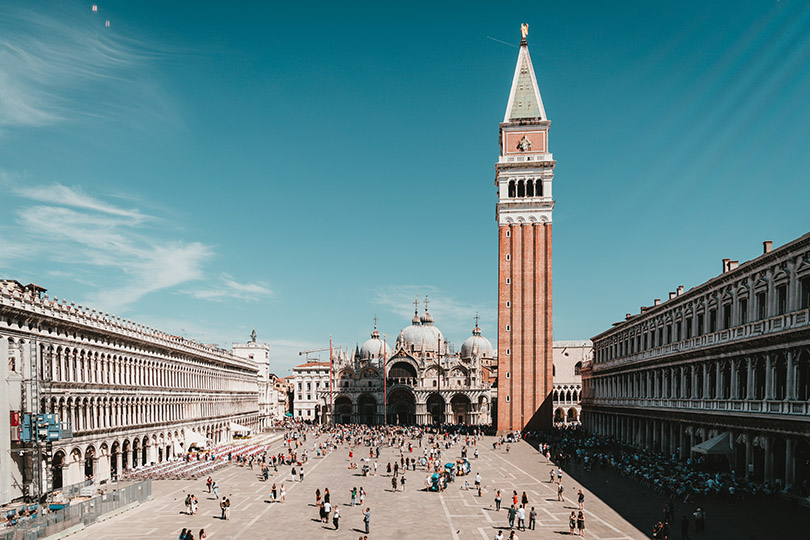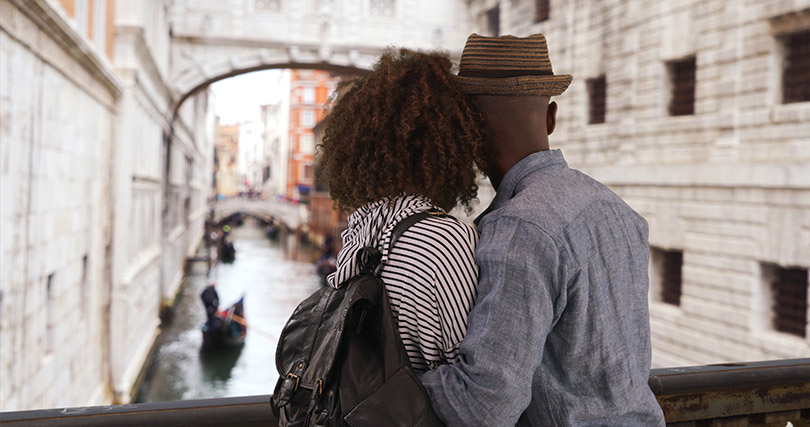
St. Mark’s Square, one of the most recognized places on Earth; credit Claudio Schwarz
Venice Attractions
This city is like a living museum, inviting you to dream, to admire, and to gaze in wonder at all you see. As a UNESCO World Heritage Site, offers an exciting array of pedestrian-friendly attractions and activities to suit many tastes.
St. Mark’s Square
Venice’s largest square is brought together with a seamless architectural motif on three sides. St. Mark’s Square is beloved as the central meeting place of Venice where people stroll, drink, and dine with friends and tour guides. Others pass through to a Vaporetto to cruise the canal. Three sides are framed in arcades, beneath which are fashionable shops and even more fashionable cafés. The opening has delightful curves and mosaics. Above it towers the brick shaft of the campanile. You can go to the top of the Torre dell’Orologio, dine at a cafe, or feed the pigeons.
Basilica of St Mark
One of the most recognized churches in the world, the Basilica (was originally the Doge’s private chapel, decorated with Byzantine art treasures that are part of the booty brought back by Venetian ships after the fall of Constantinople. The gold-covered mosaic pictures above the doorways on the façade hint at the 4,240 square meters of gold mosaics covering the domes and walls. These set a distinctly Byzantine tone to its soaring interior, but you’ll find treasures from other periods, including later mosaics designed by Titian and Tintoretto. The golden altarpiece, the Pala d’Oro, was begun by early 12th-century artists, and centuries later, adorned with nearly 2,000 gems and precious stones.
Torre dell’Orologio
This Clock Tower on the basilica, facing St. Mark’s Square is surmounted by a pair of bronze Moors that strike the large bell each hour. The face of the clock shows phases of the moon and the zodiac in gilt on a blue background. Above the clock is a small balcony and a statue of the Virgin Mary. The winged lion of St. Mark and the mosaic of gold stars against a blue background was added in 1755 by Giorgio Massari. The tower was built in the 15th century and is typical of Venetian Renaissance architecture. As the Moors strike each hour, you can see the 3 Magi led past the Madonna by an angel.
Drone video of Venice by <strong>ExploredbyUs
Campanile
Standing like a giant exclamation point above the expanse of Piazza San Marco, the Campanile is not the first to stand here. The original one, erected as a lighthouse in 1153, collapsed into the square in 1902. As you might expect construction methods improved when it was rebuilt on a firmer footing. In the loggia at the base, you can see Sansovino’s four bronze masterpieces between the columns, all of which were rescued from the rubble after the collapse. The Campanile has a grimmer side to its history: in the Middle Ages, prisoners, including renegade priests, were hoisted halfway up the outside in cages, where they hung suspended for weeks. The Campanile is popular for views across the city and the Adriatic Sea. Visit early or late in the day for shorter lines up the lift.
Doge’s Palace
When visitors were received by the Doges inside it was considered an honor. See the gold-vaulted Scala d’Oro in the palace chamber. The grandeur is astonishing. You’ll see works by all the great Venetian artists, including Paradise — the largest oil painting in the world. Lines for admission to the Doge’s Palace are often long, but you can avoid these, and see sections of the palace not open to general visitors, with a Skip the Line: Doge’s Palace Ticket and Tour.
Bridge of Sighs
By private tour, you can walk across the Bridge of Sighs to the dark cells of the Prigioni — the prison from which Casanova made his famous escape. The Bridge of Sighs is from the Ponte della Paglia, on the Riva degli Schiavoni behind the Doge’s Palace.

Couple admiring gondolas traveling under the Bridge of Sighs, Venice
Grand Canal
Curving the city and connecting major attractions from the Bus Terminal and Trans Station is this historic and remarkable waterway. Only 4 bridges cross its 3.4-mile length. You’ll enjoy gondolas, water taxis, and vaporetto stops between bridges. The Grand Canal and nearby small canals were prime choice for the leading merchant families of Venice. For best appreciation, see the palaces on a Venice Grand Canal Small Group Boat Tour, which includes smaller canals. A gondola ride along the Grand Canal at night is one of the most romantic things to do in Venice.
Rialto Bridge
Once the only bridge across the Grand Canal, Rialto Bridge marks the spot of the island’s first settlement, called Rivus Altus (high bank). Built-in 1588, some 150 years after the collapse of a previous wooden bridge, this stone arch supports two busy streets and a double set of shops. It is a favorite place for taking photos and selfies as boats approach and pass under. On one side of Rialto Bridge is the busy food market, where Venetians and chefs shop for fresh produce and seafood. In the narrow streets of San Polo, beyond the market, are artisans’ shops and mask-making studios.
Santa Maria della Salute
Rising at the tip of a peninsula across from tSt. Mark’s Square is a giant Baroque church that was built in 1630. Since the soil was unstable to support its designed weight, the architect had over a million timbers driven into the floor of the lagoon before erect the church. The magnificent dome interior includes remarkable Renaissance paintings. A convenient Vaporetto station is beside the church landing.
Teatro La Fenice
Though its name La Fenice (The Phoenix) was chosen at the first construction in 1792, like the mythical phoenix, it has risen from the ashes. The theater has been destroyed by fire three times, the last one, in 1996, leaving only the outer walls standing. Each time, it has been rebuilt and continues to be a great opera house. In the 19th century, La Fenice saw the premiers of many great Italian operas. Today, it also features ballet performances and other concerts. Even after its reopening slightly larger in 2003, tickets are very hard to get. You can tour of the Rococo interior using an audio self-guide for about 45 minutes.
Ca’ d’Oro
The delicate marble displays lace-like stone craftsmanship in the most perfect example of Venetian Gothic architecture. This façade was originally covered in paint and gold. Along with the Porta della Carta in the Palazzo Ducale, it was created by Bartolomeo Bon. You can admire the interior, too, as this palazzo is now an art museum, restored to provide both a setting for the artworks and a look at the way wealthy Venetians lived in the 15th and 16th centuries. Baron Giorgio Franchetti gave his Titian, Mantegna, Tullio Lombardo, and Bernini art collection to the state in 1922, which converted it into a museum.
WEBSITE: https://www.cadoro.org/?lang=en
Gallerie dell’Accademia
This Fine arts museum, called “Accademia”, this museum has the most comprehensive collection of 15th-18th-century Venetian paintings in existence. Much of the collection was assembled from monasteries and churches that were closed and from the clearing of palaces of noble families, now displayed in the former Monastery of Santa Maria della Carità. Some of the galleries contain Venetian Gothic Paintings and gilded 15th-century ceilings. Highlights of the 15th- and 16th-century paintings are St. George by Andrea Mantegna, St Jerome and a Donor by Piero della Francesca, and Madonna and Saints by Giovanni Bellini and so much more. It is located on the Grand Canal.
Peggy Guggenheim Collection
The art collections of heiress Peggy Guggenheim are housed in her former home alongside the Grand Canal. This great art museum concentrates on American and European art from the first half of the 20th century. That means you’ll see Surrealist, Cubist, Futurist, and avant-garde artworks by Picasso, Dali, Mondrian, Kandinsky, Ernst, Magritte, and Pollock, and traveling exhibitions bring from other major artists. In the museum’s sculpture gardens are refreshing to visit as well.
Murano
Board a vaporetto over to Murano, home of Venice’s fabled glass workers. They were sent here in the 13th century in the hope of decreasing the risk of fire from one of the glass furnaces sweeping through Venice’s tightly compacted center. The Venetian Council of Ten decreed in 1454: “If a glassblower takes his skill to another country to the detriment of the Republic he shall be ordered to return; should be refuse, his nearest relatives shall be thrown into prison so that his sense of family duty may induce him to return; should he persist in his disobedience secret measures shall be taken to eliminate him wherever he may be.” It was a lot easier to keep track of them if they were confined to an island. The canal sides today are lined by glass showrooms and studios, showing everything from cheap imported trinkets to exquisite works of art.
